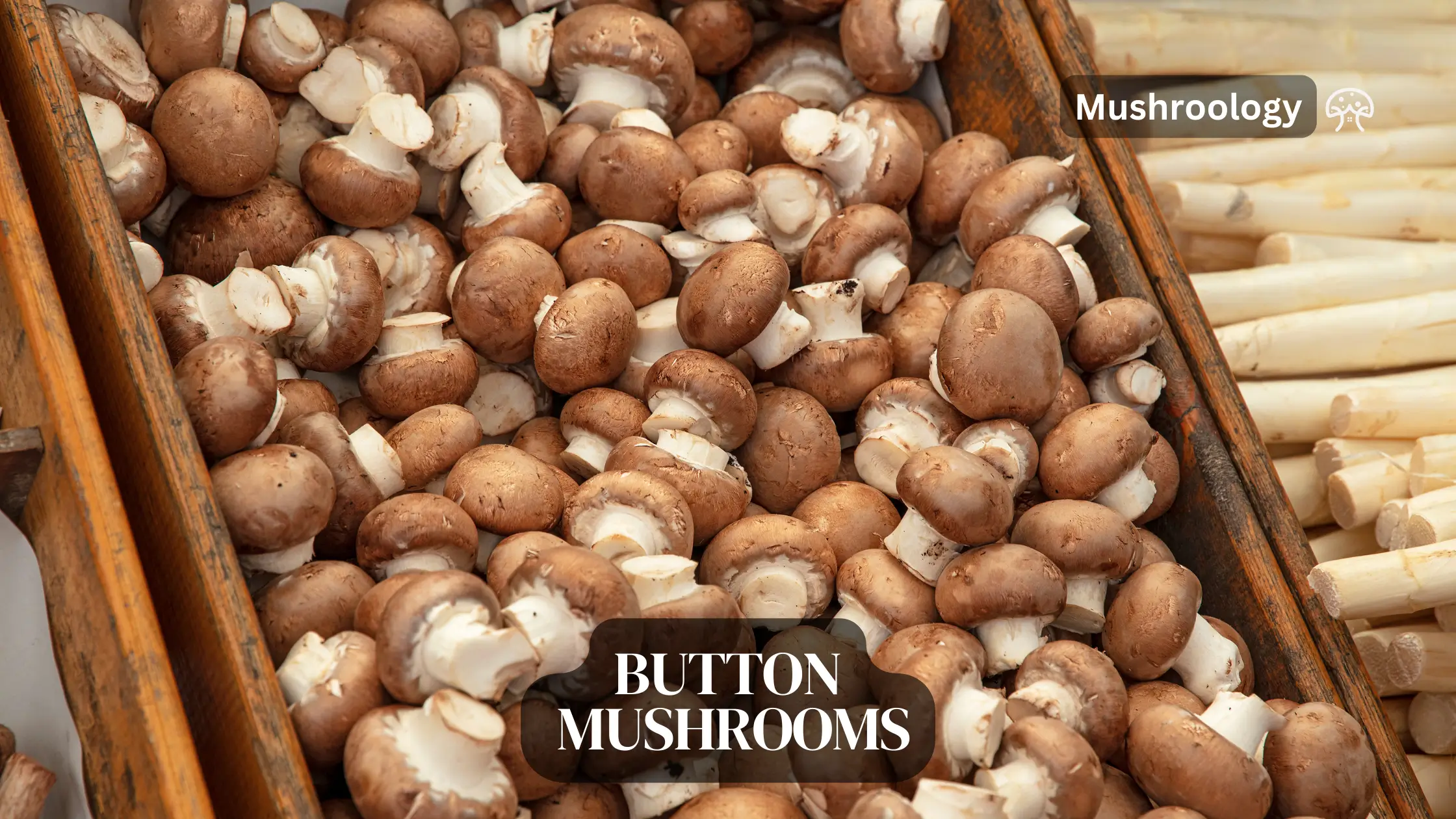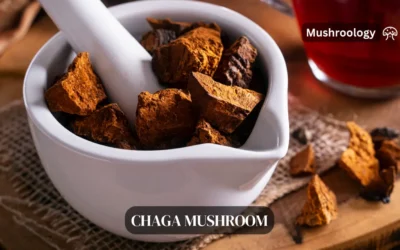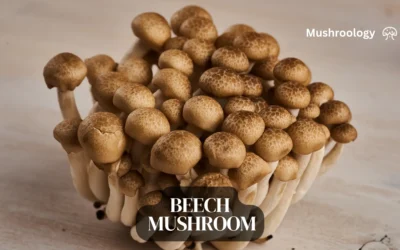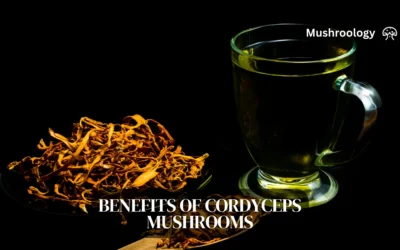Did you know that button mushrooms, scientifically known as Agaricus bisporus, are the most popular edible fungi in the world? These small fungi pack a punch when it comes to flavor and versatility in the kitchen. But there’s more to button mushrooms than meets the eye.
Key Takeaways:
- Button mushrooms, or Agaricus bisporus, are the most popular edible fungi in the world.
- They are versatile in the kitchen and offer unique health benefits.
- Agaricus bisporus has a rich taxonomical history.
- Organic farming tips can help you cultivate high-quality button mushrooms.
- Stay tuned for delicious recipes featuring these nutritious fungi.
What is Agaricus bisporus?
Agaricus bisporus, commonly known as button mushroom, white mushroom, or champignon, is an edible fungi species found worldwide. It is the most popular edible mushroom and generates significant revenue in the commercial mushroom business.
Button mushrooms grow in rich soils, often near horse manure or compost piles. They can be found in grasslands and are widespread in the northern hemisphere, with some presence in tropical climates. The taste of Agaricus bisporus is subtly umami, blending earthy and meat-like flavours, making it a versatile ingredient.
Varieties of Button Mushrooms
While the specific varieties of Agaricus bisporus can be a subject of debate and confusion, there are at least six commonly recognized varieties of button mushrooms. These varieties may differ in colour and size, but they offer similar nutritional values. The most prevalent varieties include:
| Variety | Colour | Size |
|---|---|---|
| Agaricus bisporus var. albidus | White | Small to medium |
| Agaricus bisporus var. bisporus | Brown | Small to medium |
| Agaricus bisporus var. avellaneous | Light brown to yellow | Small to medium |
The distinguishing factors among these varieties can be observed in their appearance and coloration, making each variety visually unique.
“The different varieties of button mushrooms offer a diverse range of colors and sizes, adding visual appeal to culinary creations.” – Mushroom enthusiast
Historical and Taxonomical Background
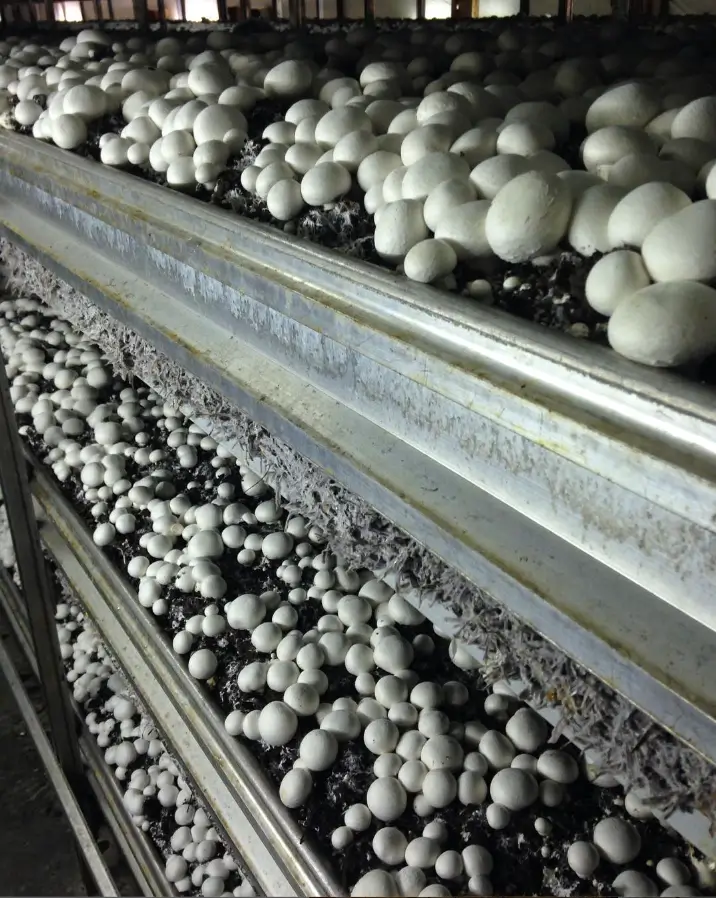
Agaricus bisporus, also known as button mushrooms, has a fascinating history of cultivation and consumption. These mushrooms were highly valued by ancient civilizations like the Ancient Egyptians, who considered them a delicacy. The cultivation of Agaricus bisporus can be traced back to centuries ago, making it one of the oldest cultivated mushrooms in human history.
In modern mycology, Agaricus bisporus garnered attention in the 1890s, when it was first reported and studied. Charles Horton Peck, an esteemed mycologist, described the species in detail in 1900, further establishing its taxonomical background. The taxonomy of Agaricus bisporus was later refined and established by David Malloch in the 1970s, shedding light on its classification and characteristics.
While further research and discoveries have been made since then, the taxonomical structure of Agaricus bisporus remains largely unchanged. The historical and taxonomical background of these mushrooms provides insights into their significance and prominence both in ancient times and the field of mycology.
Health Benefits of Button Mushrooms
Button mushrooms, scientifically known as Agaricus bisporus, offer a range of health benefits that can enhance your overall well-being. While specific information may be limited, recent research suggests that these fungi contain compounds with immune-boosting properties. These compounds have shown potential as anticancer agents and possess anti-inflammatory effects.
One of the noteworthy aspects of button mushrooms is their protein content. These mushrooms are a rich source of proteins, which are essential for building and repairing tissues in the body. Moreover, button mushrooms are packed with vitamins, including various B vitamins, that play a vital role in supporting bodily functions such as cell growth and maintaining a healthy nervous system.
Studies have also indicated that button mushrooms may contribute to cholesterol management. Consuming button mushrooms as part of a balanced diet has been associated with potential cholesterol-lowering effects. This can be beneficial for maintaining heart health and reducing the risk of cardiovascular diseases.
Furthermore, button mushrooms can aid in weight management. With their low-calorie and fat content, these mushrooms can be included in a weight-conscious diet. They provide essential nutrients and contribute to a feeling of fullness, which can support healthy eating habits and weight control.
Overall, button mushrooms offer a range of health benefits that make them a valuable addition to your diet. From their immune-boosting properties to their nutritional value, these fungi can contribute to your well-being in various ways.
Natural Habitat and Cultivation
Button mushrooms, scientifically known as Agaricus bisporus, thrive in various environments, especially in temperate climates. They can be found in grasslands and areas rich in manured soil or compost piles. While their specific preferences remain largely unknown, button mushrooms are renowned for their adaptability and ease of cultivation. Whether you’re a beginner or a seasoned home cultivator, growing these delectable fungi is a breeze, thanks to their low maintenance requirements.
The adaptability of Agaricus bisporus allows for both natural and artificial cultivation. Home gardeners often choose to grow button mushrooms due to their simplicity and consistent results. They can be successfully cultivated indoors, making them an ideal choice for year-round production.
If you’re considering growing button mushrooms, choosing the right substrate, typically consisting of a mixture of compost and other organic materials is important. The substrate serves as the food source for the mushroom mycelium. Button mushrooms are well-suited to grow in compost piles, benefiting from the nutrient-rich environment. These piles can be created using various organic materials such as straw, horse manure, and agricultural waste.
“Button mushrooms are incredibly versatile and can be easily cultivated in a controlled environment, providing an abundant supply of fresh mushrooms for culinary delights.”
Finding the Right Soil
When cultivating button mushrooms, the quality of the soil is essential. Optimal soil conditions can result in better yields and healthier mushrooms. The soil should be well-draining, as excessive moisture can lead to mold or fungal diseases. Additionally, ensuring proper ventilation and humidity levels in the growing area helps create a favorable environment for the mushrooms to thrive.
Creating Ideal Compost Piles
Compost piles play a crucial role in button mushroom cultivation, as they provide the necessary nutrients for the mushrooms to grow. The compost should be properly aged and well-rotted to maximize its benefits. Using a compost thermometer to monitor the temperature is recommended, as it should reach and maintain the optimal range of 130-160°F (54-71°C) during the active composting phase.
| Factors | Ideal Conditions |
|---|---|
| Temperature | 60-65°F (15-18°C) |
| Humidity | 80-90% |
| Lighting | Low-intensity diffused light |
| pH Level | 7-7.5 (mildly alkaline) |
| Aeration | Regularly monitor and maintain proper air exchange |
These guidelines may vary depending on the specific cultivation method and environmental conditions.
Once the compost piles are well-prepared, they can be inoculated with Agaricus bisporus spawn. The spawn serves as the source of mycelium, which eventually develops into the button mushrooms. The spawn is usually mixed evenly into the compost, allowing the mycelium to colonize and grow.
Throughout the cultivation process, it is important to maintain proper hygiene and mitigate the risk of contamination. Good sanitation practices, such as sterilizing equipment and maintaining a clean growing environment, help ensure successful cultivation.
With patience and care, you’ll soon be rewarded with a bountiful harvest of button mushrooms, ready to be enjoyed in a variety of delicious dishes.
Growing Button Mushrooms
Button mushrooms can be cultivated at home using organic farming practices. This process involves various steps, including spawn preparation, substrate composition, composting, sterilization techniques, inoculation, and environmental control.
One of the key factors to consider is humidity management, as button mushrooms thrive in a humid environment. Proper temperature regulation is also crucial for their growth, with an ideal range between 16-21°C (60-70°F). Adequate lighting conditions, such as indirect natural light or artificial light, are necessary to promote healthy mushroom development.
Pest and disease management is another essential aspect of button mushroom cultivation. Regular monitoring and preventive measures can help protect the mushrooms from common pests and diseases. Organic farming practices should be prioritized to minimize the use of synthetic chemicals and maintain an environmentally friendly approach.
When it comes to substrate composition, button mushrooms require a specific mixture of organic materials such as compost, straw, and gypsum. The composition of the substrate plays a vital role in providing the necessary nutrients for mushroom growth.
Proper cultivation techniques ensure the production of high-quality, organic button mushrooms in a controlled environment, allowing you to enjoy fresh and delicious mushrooms right from your own home.
Spawn Preparation
Spawn preparation involves the creation of a mycelial starter culture, which serves as the foundation for mushroom growth. The spawn is typically made by mixing a small amount of mycelium with a sterilized grain or other suitable medium. This mixture is then incubated until the mycelium colonizes the entire substrate.
Substrate Composition
The substrate composition for button mushroom cultivation is critical for providing the necessary nutrients and support for mycelium growth. The ideal substrate typically consists of a mix of organic materials such as compost, straw, and gypsum. The exact composition may vary depending on specific growing conditions and regional availability of materials.
Composting Process
The composting process involves the decomposition of organic materials to create a nutrient-rich substrate for mushroom cultivation. It usually requires a balance of carbon-rich (such as straw) and nitrogen-rich (such as poultry manure) materials, along with moisture and aeration. The compost pile needs to be regularly turned to ensure proper decomposition and to prevent the growth of harmful microorganisms.
Sterilization Techniques
Sterilization techniques are crucial for preventing the growth of competing organisms that can hinder mushroom development. Common methods include steam sterilization and hot water pasteurization. The chosen technique depends on the scale of cultivation and available equipment.
Inoculation Methods
Inoculation involves introducing spawn into the sterilized substrate to initiate the growth of mycelium. There are several inoculation methods, including top dressing, sandwich method, and tray spawning. Each method offers specific advantages and challenges, so choosing the most suitable one depends on individual preferences and resources.
Environmental Control
Creating and maintaining a controlled environment is essential for successful button mushroom cultivation. This includes managing humidity levels, providing consistent temperature, and controlling light exposure. Additionally, proper ventilation and air exchange are crucial for preventing the build-up of carbon dioxide and ensuring healthy mushroom growth.
| Button Mushroom Cultivation | Benefits |
|---|---|
| Humidity Management | Ensures optimal mushroom growth and prevents drying out |
| Temperature Regulation | Allows for ideal growth conditions and prevents overheating |
| Lighting Conditions | Promotes mushroom development and triggers fruiting |
| Pest and Disease Management | Protects mushrooms from harmful pests and diseases |
| Organic Farming Practices | Promotes sustainability and produces chemical-free mushrooms |
| Spawn Preparation | Ensures a healthy mycelial culture for mushroom growth |
| Substrate Composition | Provides essential nutrients for mycelium growth |
| Composting Process | Creates a nutrient-rich substrate for mushroom cultivation |
| Sterilization Techniques | Prevents contamination and promotes healthy mushroom development |
| Inoculation Methods | Facilitates the introduction of spawn into the substrate |
| Environmental Control | Maintains optimal conditions for mushroom growth |
Harvesting and Yield Optimization
Harvesting button mushrooms requires specific techniques to ensure optimal yield and preserve their quality. It is crucial to harvest the mushrooms when they reach the desired size and maturity, typically before the caps fully open. This ensures that they have a firm texture and an enhanced flavor.
Proper sanitation and handling techniques are essential to maintain the quality of the mushrooms. The mushrooms should be carefully picked and placed in clean containers to prevent contamination. It is also important to handle them gently to avoid bruising or damaging the delicate caps.
Implementing crop rotation practices can significantly impact the yield and health of button mushrooms. Crop rotation helps prevent the build-up of pests, diseases, and pathogens in the cultivation area. By rotating the mushroom beds with different crops, you can disrupt the lifecycle of harmful organisms and maintain a healthy growing environment.
Harvesting Techniques for Button Mushrooms
When it comes to harvesting button mushrooms, there are a few key techniques to keep in mind:
- Use a sharp knife or scissors to cut the mushrooms at the base of the stem. Avoid pulling or twisting the mushrooms, as this can damage the mycelium, affecting future mushroom growth.
- Harvest the mushrooms when they have fully expanded caps but before the gills start to darken or release spores.
- Inspect each mushroom for signs of maturity, such as an open veil or slightly separated cap from the stem.
By following these harvesting techniques, you can ensure that your button mushrooms are harvested at the optimal time, resulting in the best flavor and texture.
Yield Optimization Strategies
To optimize the yield of button mushrooms, growers can employ various strategies:
- Optimize environmental conditions, such as temperature, humidity, and lighting, to create a favorable growing environment for the mushrooms.
- Use high-quality spawn that is free from contamination. The quality of the spawn directly impacts the growth and yield of the mushrooms.
- Pay attention to substrate composition and ensure it provides the necessary nutrients for mushroom growth. Adjusting the substrate pH and moisture content can also affect yield.
Implementing these strategies, along with regular monitoring and adjustments, can significantly increase the yield of button mushrooms.
| Techniques for Yield Optimization | Benefits |
|---|---|
| Proper environmental control | Optimal conditions for mushroom growth and development, leading to increased yield |
| High-quality spawn | Healthy mycelium and improved colonization, resulting in higher mushroom yields |
| Attention to substrate composition | Provides essential nutrients for mushroom growth, leading to enhanced yield |
Incorporating crop rotation practices and implementing effective harvesting techniques are key steps in maximizing the yield and quality of button mushrooms. By following these strategies, growers can ensure a successful harvest and deliver the best-quality mushrooms to their customers.
Post-Harvest Processing and Storage
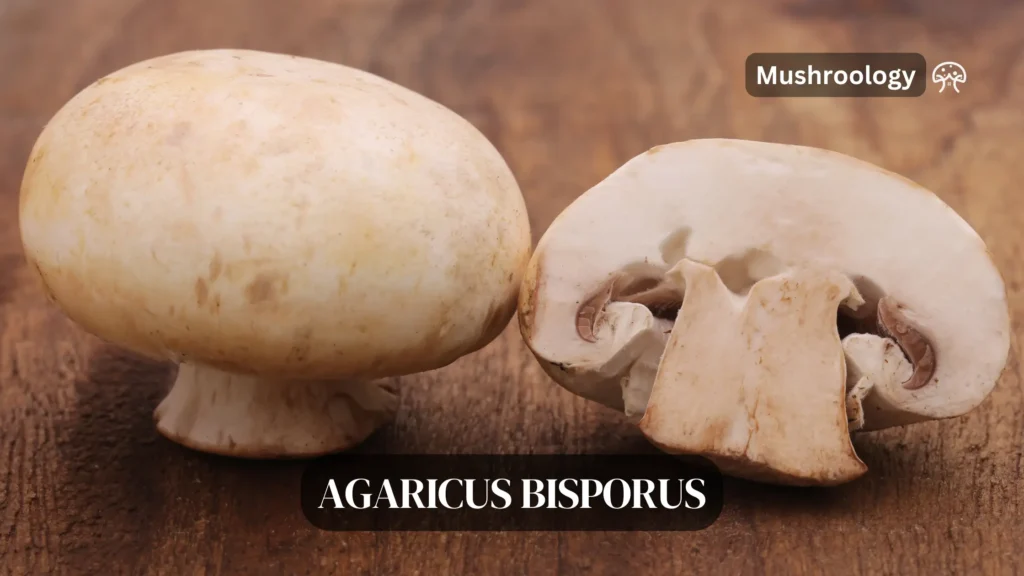
After harvesting, proper post-harvest processing is crucial to ensure the quality and longevity of button mushrooms. It involves removing debris and ensuring cleanliness to maintain their freshness. Here are some key steps for post-harvest processing:
- Rinsing: Start by rinsing the mushrooms gently under cool running water. This will help remove any surface dirt or debris.
- Light brushing: Use a soft brush or cloth to lightly brush the mushrooms, focusing on areas with stubborn dirt. Avoid using excessive force that may damage the delicate caps.
Once the post-harvest processing is complete, proper storage techniques are essential to extend the shelf life of button mushrooms. Here are some storage guidelines:
- Cool and dark environment: Store the mushrooms in a cool and dark place, such as a refrigerator, to slow down the natural aging process.
- Well-ventilated: Ensure that the storage area is well-ventilated to prevent moisture buildup, which can lead to spoilage.
- Proper packaging: Place the mushrooms in a paper bag or a perforated container to control moisture levels. This allows for better air circulation and helps prevent moisture accumulation.
By following these post-harvest processing and storage techniques, you can prolong the freshness and quality of your button mushrooms, ensuring that they remain optimal for consumption.
Nutritional Value and Health Benefits
Button mushrooms, scientifically known as Agaricus bisporus, are not only delicious but also packed with essential vitamins and minerals that contribute to a healthy diet. These mushrooms are low in fat and calories, making them an excellent choice for those watching their weight.
When it comes to vitamins, button mushrooms are a great source of B vitamins, including riboflavin, pantothenic acid, and niacin. These vitamins play a crucial role in various bodily functions, such as energy production, red blood cell formation, and maintaining healthy skin and hair.
In addition to vitamins, button mushrooms also provide important minerals such as potassium, calcium, and phosphorus. These minerals are necessary for maintaining proper nerve function, promoting strong bones and teeth, and supporting overall health and well-being.
The consumption of button mushrooms has been associated with numerous health benefits. These mushrooms have been shown to provide support to the immune system, helping to defend against common illnesses and infections. Additionally, some studies suggest that button mushrooms may aid in managing cholesterol levels, promoting heart health.
Overall, incorporating button mushrooms into your diet can contribute to a well-balanced nutritional intake and provide potential health benefits. Enjoy them in salads, stir-fries, soups, or as a versatile ingredient in various dishes.
| Nutrient | Amount per 100g |
|---|---|
| Calories | 22 |
| Protein | 3g |
| Fat | 0.3g |
| Carbohydrates | 3.3g |
| Fiber | 1g |
| Potassium | 318mg |
| Calcium | 5mg |
| Phosphorus | 105mg |
| Riboflavin (Vitamin B2) | 0.4mg |
| Pantothenic Acid (Vitamin B5) | 1.5mg |
| Niacin (Vitamin B3) | 4.5mg |
Considerations for Organic Farming
In the realm of organic farming, it’s important to adhere to certain key considerations when cultivating button mushrooms. By following organic practices, farmers can minimize their environmental impact while promoting sustainable and ethical farming methods. Let’s take a closer look at some essential factors to keep in mind:
1. Optimal Carbon Dioxide Levels
Button mushrooms thrive in environments with adequate carbon dioxide (CO2) levels. It’s crucial to maintain CO2 concentrations within the optimal range to support their growth and development. This can be achieved by ensuring proper ventilation and employing techniques like CO2 enrichment systems, which can supplement levels in controlled environments.
2. Proper Lighting Conditions
Lighting plays a crucial role in the cultivation of button mushrooms. Adequate exposure to natural or artificial light is vital for their efficient photosynthesis and overall development. By simulating outdoor lighting conditions in indoor cultivation setups or ensuring appropriate natural light availability in open-air environments, farmers can optimize their yield and mushroom quality.
3. Balanced Soil pH
The pH balance of the soil is a critical factor for successful button mushroom cultivation. These fungi prefer a slightly acidic to neutral pH range, typically between 6 and 7. Maintaining the appropriate pH levels ensures optimal nutrient availability and helps prevent the growth of undesirable organisms that could hamper mushroom production.
4. Implementation of Crop Rotation
Crop rotation is an essential practice in organic farming, including button mushroom cultivation. By periodically rotating crops, farmers can disrupt pest and disease cycles, reduce the risk of soil nutrient depletion, and maintain overall soil health. Proper crop rotation strategies contribute to sustainable production and support the longevity of organic farming operations.
By considering these crucial factors in organic farming, farmers can create a conducive environment for button mushrooms to thrive, while minimizing the use of synthetic chemicals and promoting sustainable agricultural practices.
Tips for Yield Optimization and Quality Control
When cultivating button mushrooms, optimizing yield and maintaining quality control are essential for successful cultivation. Paying attention to environmental conditions, spawn quality, and substrate composition can significantly impact the overall crop production. Here are some tips to help you achieve maximum yield and ensure consistent quality:
Monitor and Maintain Optimal Environmental Conditions
- Control temperature, humidity, and carbon dioxide levels to create a favorable growing environment for button mushrooms.
- Regularly monitor and adjust these factors to ensure optimal conditions throughout the cultivation process.
- Provide adequate ventilation to regulate air exchange and prevent the build-up of contaminants.
Ensure High-Quality Spawn
- Choose reputable suppliers for purchasing spawn to ensure its quality and viability.
- Inspect the spawn for any signs of contamination, such as mold or off-color patches, before inoculating the substrate.
- Handle the spawn with care to prevent damage and maintain its integrity.
Maintain Consistent Substrate Composition
- Prepare the substrate using a consistent and well-balanced composition of organic materials, such as straw, horse manure, and gypsum.
- Ensure proper moisture content in the substrate to promote mycelial growth without encouraging bacterial or fungal contamination.
- Regularly monitor the pH level of the substrate and make necessary adjustments to maintain an optimal range.
Implement Proper Sterilization Techniques
- Thoroughly sterilize the substrate before inoculation to eliminate any potential sources of contamination.
- Use appropriate sterilization methods, such as steam or heat, based on the type of substrate and the scale of cultivation.
- Follow sterilization protocols and recommended duration to ensure the complete eradication of pathogens.
Harvest Timely and Handle with Care
- Observe the mushrooms closely and harvest them at the right stage of maturity, usually before the caps fully open.
- Use clean tools and gentle handling techniques during harvesting to minimize damage and prevent contamination.
- Ensure proper sanitation practices throughout the harvesting process to maintain the quality and extend the shelf life of the harvested mushrooms.
By implementing these tips, you can optimize the yield of your button mushroom cultivation and maintain consistent quality throughout the process. Paying attention to environmental conditions, spawn quality, and substrate composition will contribute to the overall success of your crop.
Remember, successful cultivation requires careful planning, attention to detail, and consistent monitoring. Enjoy the satisfaction of growing high-quality button mushrooms while optimizing your yield!
Whether used in cooking or for medicinal purposes, button mushrooms are a valuable addition to any kitchen or cultivation setup. Their culinary versatility allows them to be incorporated into various dishes, bringing a unique depth of flavor. Furthermore, their nutritional value and potential health benefits make them a popular choice for those seeking to enhance their overall well-being.
10 Science-Backed Health Qualities of Button Mushrooms
Mushrooms, particularly the humble button mushroom, are not just a delicious addition to meals; they’re packed with a variety of health benefits. Here’s a rundown of ten science-backed qualities that make button mushrooms a must-add to your diet.
- Cancer Risk Reduction: Research indicates that mushrooms can lower your risk of developing cancer. This is attributed to their content of antioxidants like ergothioneine, which helps prevent cellular damage[1][4].
- Heart Health: Mushrooms are naturally low in sodium, containing only five milligrams per cup, making them an excellent food choice for maintaining healthy blood pressure levels[1][4].
- Cognitive Health: Eating mushrooms may protect your brain against cognitive decline. Studies have shown that consuming mushrooms regularly can lower the odds of mild cognitive impairment (MCI), a precursor to Alzheimer’s disease[1][4].
- Immune System Support: Mushrooms contain nutrients like selenium, vitamin D, and vitamin B6, which support a healthy immune system by boosting the production of antioxidant enzymes and reducing inflammation[1].
- Vitamin D Source: Unique among produce, mushrooms can provide vitamin D, essential for bone health and immune function. Exposing mushrooms to sunlight increases their vitamin D content[1].
- Gut Health: The polysaccharides in mushrooms act as prebiotics, stimulating the growth of healthy bacteria in the gut. This can improve digestive health and potentially enhance overall well-being[1][2].
- Lower Cholesterol: Substituting mushrooms for red meat can reduce your intake of calories, fat, and cholesterol, helping to maintain healthy cholesterol levels. Shiitake mushrooms, in particular, are known for their cholesterol-lowering effects[1].
- Reduced Sodium Intake: The savory flavor of mushrooms can reduce the need for added salt in dishes, helping to keep sodium intake and blood pressure low[1].
- Antioxidant Rich: Mushrooms are a rich source of antioxidants, which protect the body from stress and prevent cell damage. This can reduce the risk of chronic diseases such as heart disease and cancer[5].
- Nutrient Dense: Despite being low in calories, mushrooms are packed with nutrients, including protein, fiber, B vitamins, selenium, copper, iron, and phosphorus, making them a valuable addition to any diet[3].
Citations:
[1]https://www.uclahealth.org/news/7-health-benefits-of-mushrooms
[2] https://www.hsph.harvard.edu/nutritionsource/food-features/mushrooms/
[3] https://www.medicalnewstoday.com/articles/278858
[4] https://longevity.technology/lifestyle/mushrooms-reasons-you-should-eat-them/
[5] https://health.clevelandclinic.org/benefits-of-mushrooms

